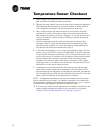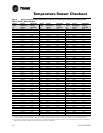
16 RLC-SVD03A-EN
Temperature Sensor Checkout
4. Again measure the temperature at the sensor with an accurate thermom-
eter; record the temperature reading observed.
5. Remove the sensor leads from the terminal strip or unplug the respective
MTA. Measure the resistance of the sensor directly or probe the MTA
with a digital volt-ohmmeter. Record the resistance observed.
6. Next, with the sensor still disconnected from the module, check the
resistance from each of the sensor leads to the control panel chassis.
Both readings should be more than 1 Megohm. If not, the sensor or the
wiring to the sensor is either shorted or leaking to chassis ground and
must be repaired.
7. Select the appropriate sensor table and locate the resistance value
recorded in Step 5. Verify that the temperature corresponding to this
resistance value matches (i.e. within the tolerance range specified for
that sensor) the temperature measured in Step 4.
8. If the sensor temperature is out of range, the problem is either with the
sensor, wiring, or the MTA connector (if applicable). If an MTA connector
is used and the thermistor reads open, first try cutting off the MTA, strip-
ping a small amount of insulation from the sensor wire's end and repeat-
ing the measurement directly to the leads. Once the fault has been
isolated in this manner, install a new sensor, connector or both. When
replacing a sensor, it is easiest to cut the sensor wire near the MTA end
and splice on a new sensor using wire nuts.
9. A decade box can be substituted for the sensor and any sensor table
value used to relate resistance to temperature. By removing the MTA
plug and applying the resistance to the proper pin terminals, the tempera-
ture, as sensed by the UCM, can be confirmed. Using the CLD menu dis-
plays, scroll to the display of the temperature of interest.
NOTE: All displayed temperatures are slew rate limited and only accurate
within a specified normal range. It is therefore important to be certain that
the temperature readings are stable and that adequate time, up to 1 minute,
is allowed after step changes in resistance inputs are made.
10. In all instances where module replacement is indicated, first perform the
power supply/fuse check according to the information in the section
“Module Power and Miscellaneous I/O” starting on page 41.


















